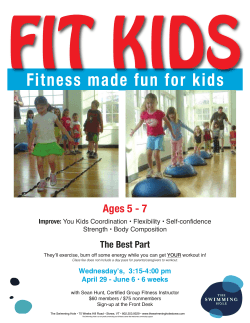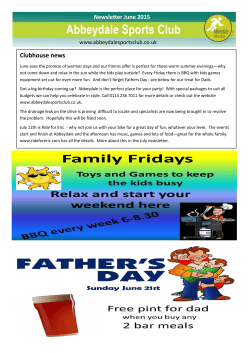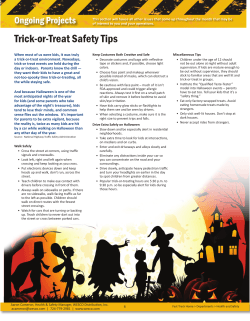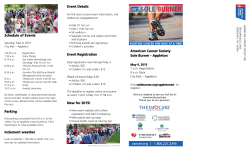
Healthy Choices, Healthy Children Frequently
Healthy Choices, Healthy Children Frequently Asked Questions The Cal Ripken, Sr. Foundation’s (CRSF) youth development curriculum begins with the 12 core lessons that Cal Ripken, Sr. taught his children and his players, which can be found in the Badges for Baseball Coaches Manual, and continues with Healthy Choices, Healthy Children. What is Healthy Choices, Healthy Children? Healthy Choices, Healthy Children is a series of guides (or flipbooks as we often call them) for coaches and mentors to continue the conversations started through the Badges for Baseball Coaches Manual and to address topics like bullying or nutrition while helping kids build their resilience or financial literacy. The conversation on choosing one’s future continues with exploring careers in STEM (science, technology, engineering, and math). Practicing leadership as a member of a sports team translates into leadership as a citizen of this country. Does Healthy Choices, Healthy Children need to be implemented as part of a CRSF program? Research in character education has shown that lessons are most effective when taught, reinforced, and taught again—woven into the fabric of the organization. Each edition of Healthy Choices, Healthy Children is designed to be used together with the Badges for Baseball Coaches Manual as part of a cohesive and ongoing program for maximum impact. For information on using Healthy Choices, Healthy Children as part of a Badges for Baseball program, please see “Starting a Badges for Baseball Program” at CRSFPortal.org/Materials under Badges for Baseball. Can I use Healthy Choices, Healthy Children editions individually or as part of another program? If your organization is not running Badges for Baseball, you can also incorporate the curriculum into your existing programs. Each edition of Healthy Choices, Healthy Children can also be used as a standalone curriculum—or you may opt to go through a several editions with your kids. Regardless of whether you’re teaching one unit or the entire series, here are some quick tips for implementation. HOW TO IMPLEMENT HEALTHY CHOICES, HEALTHY CHILDREN (HCHC) WHO: Youth ages 9-14, although some topics could be used with older youth as well A ratio of 2-3 adults per every 25-30 kids allows for better discussion as well as the opportunity to develop meaningful relationships between kids and coaches/mentors. WHAT: Editions include Adaptive Sports, Civics & Leadership, Financial Literacy, Fitness, Nutrition, Quickball, Rise Above Bullying, Resilience, STEM Careers Each edition consists of 4 lessons, all of which include a brief introduction to the topic, discussion questions, and an activity. Be sure to check out the accompanying resources, including videos, music, and worksheets, available at CRSFPortal.org/Materials. WHEN: Set a specific day of the week and time for HCHC lessons. Plan about one hour for discussion and lesson activities. WHERE: Review the Game Plan at the beginning of each HCHC edition. This will tell you what type of space might be best, what equipment might be needed, and otherwise help you plan ahead. Prior to each session, review the activity instructions so that you can have all your supplies ready and, if needed, choose an appropriate space for that specific activity. HOW: Adult coaches or mentors should use the flipbook as a guide to lead kids through discussions and activities. Each module is designed to be flexible. Maybe you wish to combine the concepts and discussion with another relevant activity that your kids are already doing, like music or dance. Be creative! Adapt discussions/activities to the needs and interests of your kids. Reinforcing lessons with volunteers and community partners These topics are great way to engage other volunteers and partners like local law enforcement agencies or other nonprofits in your community. Here are some suggestions for events or ways to enrich the program based on various HCHC topics: STEM Careers o Invite law enforcement or volunteers to talk about how they use science, technology, engineering, or math in their jobs. Resilience o Invite law enforcement and volunteers to discuss how they practice resilience and how it has helped them overcome or achieve something. Bullying o Invite law enforcement to discuss respect vs. fear and how they work to respect others and earn respect of citizens in order to protect and serve the community. Civics & Leadership o Invite law enforcement and community groups to discuss they work together with citizens and how citizens can work with various agencies in order to improve their communities. Adaptive Sports o If your organization does not serve kids with special needs, team up with a local organization that does and set up some games! Or you could set up a game with kids and Wounded Warriors or a similar organization. Financial Literacy o Invite volunteers to discuss what financial literacy and responsibility (i.e. budgeting) allows them to do (either on the job or personally). Fitness o Host a field day with together with other youth-serving organizations. o Invite law enforcement and public safety officers to discuss how staying fit helps them in their jobs and/or physical requirements to become an officer. Nutrition o Have the kids prepare healthy snacks for a younger group of kids or prepare a healthy meal as a thank you to volunteers. Quickball o Host a Quickball tournament and invite other community organizations to set up teams and play! o Ask older kids who are comfortable with the game to take the lead and teach a group of younger kids at your organization how to play Quickball.
© Copyright 2025









